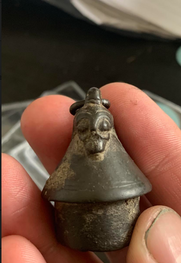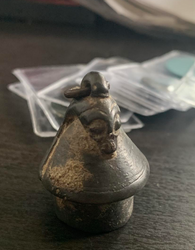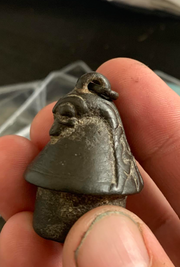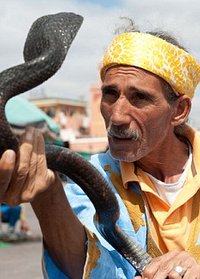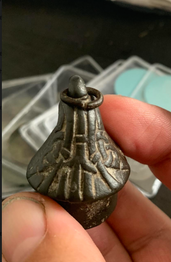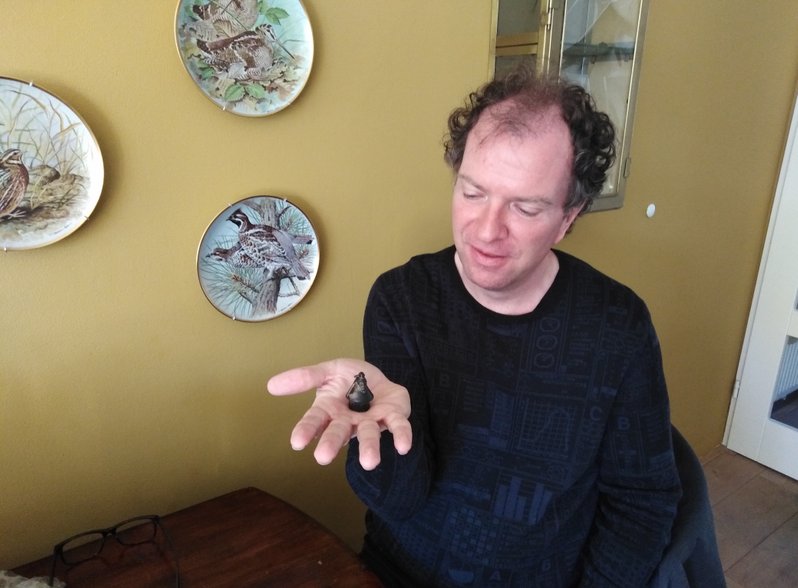Viking stopper in Hiberno-Norse Borre style
Once in a lifetime one encounters a unique object from the Viking Age. Apparantly having had functionated as some kind of stopper, to my knowledge, there isn't a second example known, regarding this type of object. Stylistically wise the decoration can be addressed as of Hiberno-Norse origin, the Norse-Gaelic. In Ireland, Scotland - including the Hebrids and the Isle of Man - from the 9th to the 12th centuries onwards a hybrid culture of people were living with a Gaelic background besides Norse immigrants - viking, or otherwise. These immigrants settled in these areas and adopted (partly) the culture of the Geal and intermingled via marriage. In - what we now call in hindsight - the Viking Age, these people distinguished themselves in their art outings on artefacts and in behaviour. They were very determined.
'Men from the east'
These 'men from the east, what is to say: immigrants from Scandinavia, still were distinguished from the 12th into the 14th centuries as such. Centuries after 'the end of the Viking era'. Eventually they assimilated in the population, but nowadays do not call someone speaking Gaelic an Englishman or woman. That is still not done, the Gael are proud still about their heritage, as the old parliament shows us, at Tynwald, on the Isle of Man. Every year, the new laws are nominated in publiq in front of the aucience.
The object measures 3,5 centimetres from bottom to top and weighs 55.68 grams wich makes it a heavy piece. It has all the appaerance of it having functionated as a - very luxury - stopper on a container with liquid. A far-reaching archaeological research might unravel the kind of liquid what might have been in the container. Another specialist in Viking Age artefacts from the United States thought the liquid might have been mead, because of the small container the stopper had been used for. Mead was consumated in small quantities, in contrary to the more usual ale. Alternatevily the container could have contained something different, like (precious) herbs or the like.
The hiberno-norse style can be distinguished in the way the face on the front of the stopper had been depicted. In the way the face is depicted and had been casted in addition we recognise the Borre style. The round 'bulging' eyes and prominent eye brows are characteristic features of this distinct style, wich places the artefact in the late 9th or 10th centuries. Above all - the artefact is 'über-viking' by the way the smith had used the 'hidden-face'technique. 'En face' we see a humanlike face with eye brows, but when one turns the artefact 45 degrees, one suddenly sees a zoomorphic/animal head, wich could depict a dragon or a snake. Depicted in a 'friendly'way. To say is, whát is depicted, not what the intention of the smith was, depicting it and the way it was intended to. The smith must have had a very high level of spatial insight and composition and 'breathes' an alltogether refinement wich I categorize among the highest level of Viking art I came across.
On the back of the stopper we see decoration in Borre style, in the form of the typical 'Borre knot' and interlace decoration. If we consider the Borre style decoration as the neck of a snake, one can argue that this is depicting the widening neck of a cobra, to be recognized from images of a snake sedator. But that, of course, is just an intepretation from on my behalf, although a taste for the exotic is a feature among the vikings, considering the Buddha figure on a bucket once found in the Oseberg ship. On top of the stopper is a small ring wich could have been used to hang the container or to carry it, although this seemingly is very vulnerable and delicate in its use. However, the owner of this artefact must have been of high class, someone who could afford such luxury and must have made quite an impression.
To conclude, beneath is depicted, with some artistic freedom, how the stopper could have been attached upon a container. Possibly during the Viking Age, something already excisted as 'a bottle of Jägermeister for underway'. We will never be sure, but impossible this assumption isn't either.
Well. I could have been with these stones until after dark, but as my wife wanted to travel on.. well.. I see you again, some day, hogback stones from Gosforth. And if you happen to be there one day, do not forget that monument on the outside...
Further on with the Cumbrian hogbacktour !
In - yes, luckily again in - St. Peter's church in Heysham, there is a truly beautiful hogback stone. The guide told us, it had been studyied by Thor Ewing, a writer, in 2000. in 'Understanding the Heysham hogback' A tenth century sculpted stone monument and its context (link), Thor Ewing tells in detail what he dicovered on the both sides of this hogback stone.
Just being brought in the church as late as the 1970's accompanied with some protest here and there among the church visitors, considered as being a token of old paganism, it had been remarkably nice preserved, and a lot of detail can be seen, still. Truly worthwile a visit.
I had a small debate with the guide in the church if the - zoomorphic, in my opinion - faces on the sides were lions (or hippo's). The guide doubted if the vikings could have known about lions. Well I guess so, concerning the runes on the Ancient Greek lion statue at the Arsenal, Venice. For example. Vikings did travel south..
But when he told me he was doubting the vikings 'discovered' (as the native inhabitants were of course, in the first place) America before Columbus, I decided to rest my case..
One has to know when to start and to end a conversation ..
Just discovered the book in a bookstore written by Geoff Holder - The guide to the mysterious Lake District, I knew there had to be another hogback stone in Lowther, St. Micheal's Church. With a promising image described in the text of 'a naval and a land-based force of shield-bearing vikings above a fish and what might be a coiled sea serpent. On the reverse is a row of female figures with snakes, possibly a representation of the hideous hag Hel'. Wow. If that did not sound as a true pagan promised land ..
Not complaing too much after all we have seen, this visit was the dissapointing one of them all. But if you wife states 'I am happy to have seen them' and I am answering 'Measuring is knowing' and the even more obligate verb 'handling 'if we did not see it at all, we wouldn't have known anything at all of how they were looking' the glass was again half full, at the last day of our journey..
The hogback stone appeared to be just being tolerated within the entrance segment part of the church. As something you never use anymore but you do not throw away - entirely. That sort of feeling emerged when seeing this hogback asylum seekers.. Bed, bath and bread, ás we say in Dutch, but no luxury at all and standing on some outcuts of wood, you would balance the table with at home..
Come on, St. Micheal's Church.. care a bit more of your 'children' !
This hogback stone was moved in the church in 1907. Hogback stones layed partially buried in the churchyard before it was dug up and moved into the church.
The promising depiction of a longship - as certainly can be seen after some studying - see http://vikingminds.co.uk/pages/longship
we have missed !
The stone itself is (157 x 50 x 30 cm) and very worn.
The hogback stones in Cumbria - very diverse in quality, but everyone worth a visit ! Especially on a gloomy day in late October ...
The churches to visit - see photos of resp. St. Andrew's church in Penrith, St. Mary's church in Gosforth, St. Peter's church in Heysham and St. Micheal's church in Lowther.
Did I miss out on another one in Cumbria ? Let me know !
In a next blog I will take you to four - still remaining utterly mysterious- statues 'guarding' the graveyard of St. Andrew's church in Dacre..
For the last blog of October 9th see this link.
References: (as always, links to where the books can be ordered are attached).
Edwards, B.J.N. Vikings in North West England - The artifacts (1998);
Emery, Gordon, CURIOUS CUMBRIA, The Lake District & Beyond: A celebration of Cumbria (2023)
Ewing, T. 'Understanding the Heysham hogback' A tenth century sculpted stone monument and its context ;
Hall, R. Viking Age archaeology in Britain and Ireland (first printed 1990, reprinted with amendments in 1995);
Holder, G. The guide to the mysterious Lake District (2009)
possibly also (as there within the part of Cumbria dealing with Carlisle, the Eden Valley, Barrow-in-Furness, Whitehaven and the west coast is being dealed with)
Holder, G. Paranormal Cumbria (2010)
http://vikingminds.co.uk/pages/longship
